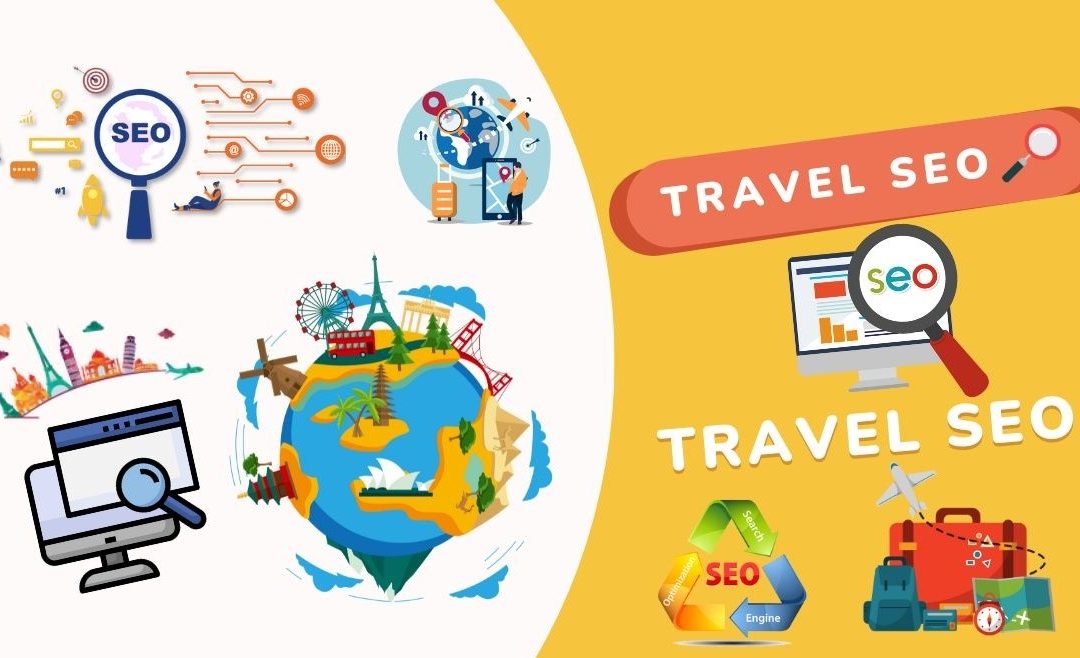In today’s digital age, where wanderlust meets the internet, the travel industry finds itself at a crossroads. The road to success in this competitive landscape is heavily paved with search engine optimization (SEO) strategies. Whether you’re a travel agency, a hotelier, or a travel blogger, understanding the importance of SEO is paramount to thriving in this dynamic industry.
Travel SEO holds immense significance for travel businesses and travelers. By optimizing their online presence, they can attract travelers from across the country and even international tourists interested in visiting. In a highly competitive market, SEO provides a competitive edge. Businesses that invest in effective SEO strategies are more likely to outrank their competitors in search engine results pages (SERPs), attracting a larger share of potential customers.
Travel SEO allows businesses to target specific demographics, such as tourists interested in specific regions or types of travel experiences (e.g., adventure travel, cultural tourism, or luxury vacations). This targeted approach ensures marketing efforts are more effective.
Compared to traditional advertising, SEO is a cost-effective way to promote travel services. It also enables businesses to set up their marketing budgets wisely and achieve a better return on investment from search engines.
Table of Contents
State the purpose of the blog to provide insights and tips for improving travel-related SEO efforts.
What is Travel SEO? & Understanding Travel SEO
Travel SEO refers to the practice of optimizing your travel website or content to rank higher in search engine results pages (SERPs).
This optimization involves various strategies and techniques.
Aimed to improve your travel website’s visibility to potential travelers or your targeted audience.
So, if someone searches for travel-related information.
Your travel website appears at the top of the search results. It significantly increases the likelihood of attracting visitors and potential customers to your travel website.
Why Travel SEO Matters?
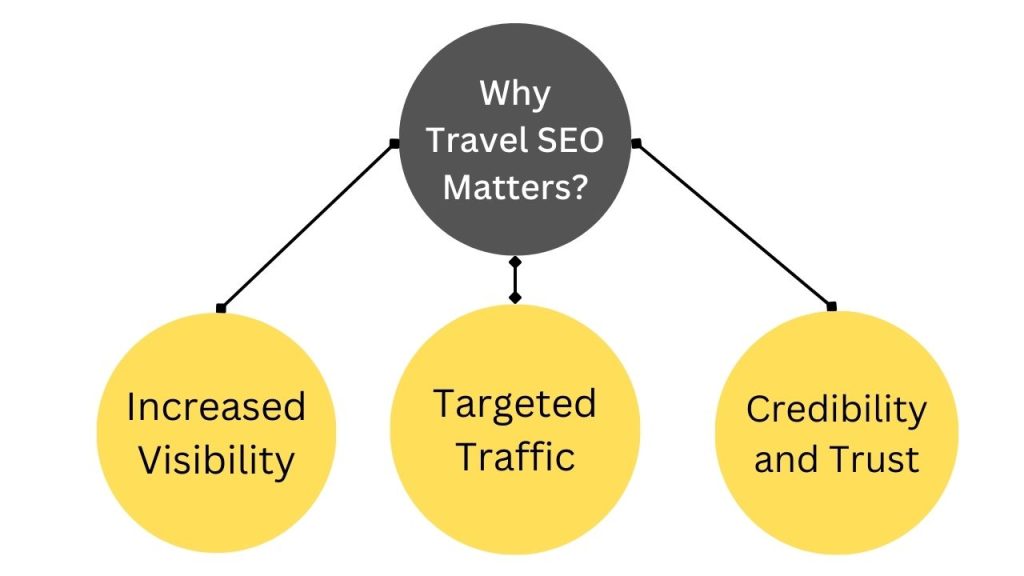
- Increased Visibility: The travel industry is highly competitive, with countless websites vying for the attention of travelers. Travel SEO helps you make a strong stand in the travel industry. It also ensures that your website is easily discoverable when users search for travel-related queries.
- Targeted Traffic: By optimizing your travel website content for travel-relevant keywords. You attract visitors or travelers who are genuinely interested in what you offer. This means higher chances of conversion, whether it’s booking a hotel room, purchasing an airline ticket, or using your travel guide or assistant. It will help you gain access to a travel agency’s services.
- Credibility and Trust: Travel Websites that appear at the top of search results are often perceived as more credible and trustworthy by users because of travel SEO. In order to result, travelers are more likely to choose a business that ranks well in search engines.
Impact of SEO on Different Travel Sectors
- Hotels: Hotels can benefit significantly from Travel SEO. Because if potential guests or travelers search for accommodation options in a specific destination. Then a well-optimized hotel website can capture their attention. Optimizing for local keywords, showcasing high-quality images, and providing useful information about the hotel and its surroundings can drive bookings.
- Airlines: Airlines can use SEO to attract travelers searching for flight tickets. Keyword optimization as per different travel destinations and for the routes of that destination, same with other services such as fares, and schedules. It also can help airlines rank higher in search engine results. Additionally, providing a seamless booking experience on the website is crucial.
- Travel Agencies: Travel agencies can use SEO to showcase their expertise and the destinations they offer. Content marketing as per SEO parameters through blog posts, destination guides, and travel tips. It can attract potential clients on their travel website.
Optimizing travel websites for long-tail keywords related to specific travel packages or services can be highly effective. - Travel Bloggers: For travel bloggers, SEO is the key to growing their readership and personal branding as well. By optimizing their blog posts for destinations as cover travel SEO for-specific keywords and creating high-quality content.
They can attract a dedicated audience. Building backlinks from authoritative travel websites also enhances a blogger’s online presence and personal branding.
Understanding Travel SEO: A Step-by-Step Guide for Beginners
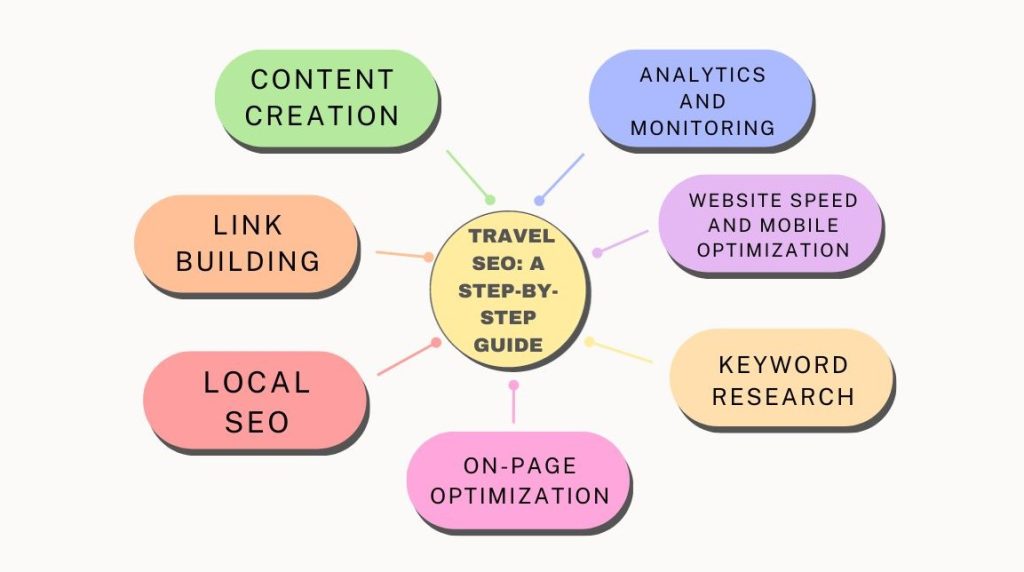
- Keyword Research: Begin by researching relevant keywords related to your travel niche because as per travel SEO. As we do for one of our websites realhimachal.in. You can use tools like Google Keyword Planner, Aherfs, or SEMrush to identify keywords as per travel SEO with decent search volume and low competition / Less Keyword Difficulty. Which also covers your serving destinations.
- On-Page Optimization: Optimize your Travel website’s on-page elements including titles, meta descriptions, and header tags. But make sure your content is valuable, informative, and well-structured.
- Local SEO: If your business serves specific locations, optimize your travel website for local SEO as well. Create a Google My Business profile, and encourage customer reviews and ratings.
- Content Creation: Regularly create high-quality, informative, and optimized content as per SEO for travel websites. It also should be engaging content related to your travel niche. Blog posts, destination guides, and travel tips can attract a broader audience.
- Link Building: Build backlinks from authoritative travel websites and blogs for your travel SEO website. Guest posting, partnerships, and outreach can help you acquire valuable backlinks.
- Website Speed and Mobile Optimization: Ensure your travel website loads quickly. It is mobile-friendly as well. Because if your website optimize as per travel seo then Google rewards mobile-friendly websites with better rankings.
- Analytics and Monitoring: Use tools like Google Analytics / Google Search Console / Ahref, / Semrush to monitor your website’s performance. Adjust your SEO strategy based on data insights.
Now that we’ve discussed the importance of Travel SEO and its impact on different sectors within the travel industry.
Let’s dive into a step-by-step guide for beginners looking to get started a Travel SEO for their website.
1.Keyword Research for Travel
In this friendly and informative guide, we’ll be your tour guides as we explore the essential art of Keyword Research for Travel SEO. We’ll uncover why keyword research is important in travel SEO how to find those perfect travel-related keywords for USA audiences, and the tools and strategies you need for an unforgettable SEO adventure.
Why is Keyword Research Important in Travel SEO?
Before we set out on our keyword expedition, let’s first understand why keyword research is the important that guides your success in Travel SEO:
- Relevance: Keywords are like signposts that lead travelers to the content on your travel website. That’s why keyword research is important and by using the right keywords, you ensure your website or blog appears in search results. It also helps you to land potential travelers on your website. It can be about destinations, accommodations, or travel tips.
- Targeted Traffic: Effective keyword research helps you attract the right audience. It will make people genuinely interested in what you have to offer on your travel website. These are the travelers more likely to engage with your content, whether it’s booking a vacation or reading your travel blog.
- Competitive Edge: Understanding your competitors’ keywords can give you a competitive advantage. It allows you to identify opportunities to rank higher in search results and outshine the competition of travel industry.
Now that we’re geared up and ready to roll, let’s embark on our quest to discover the perfect travel keywords for USA audiences.
Start with Seed Keywords: Our journey begins with seed keywords. These are the broad terms related to your travel niche. If you’re focusing on travel in the USA, consider keywords like “USA travel,” “American vacations,” or “US travel destinations.”
How to select keywords for travel SEO?
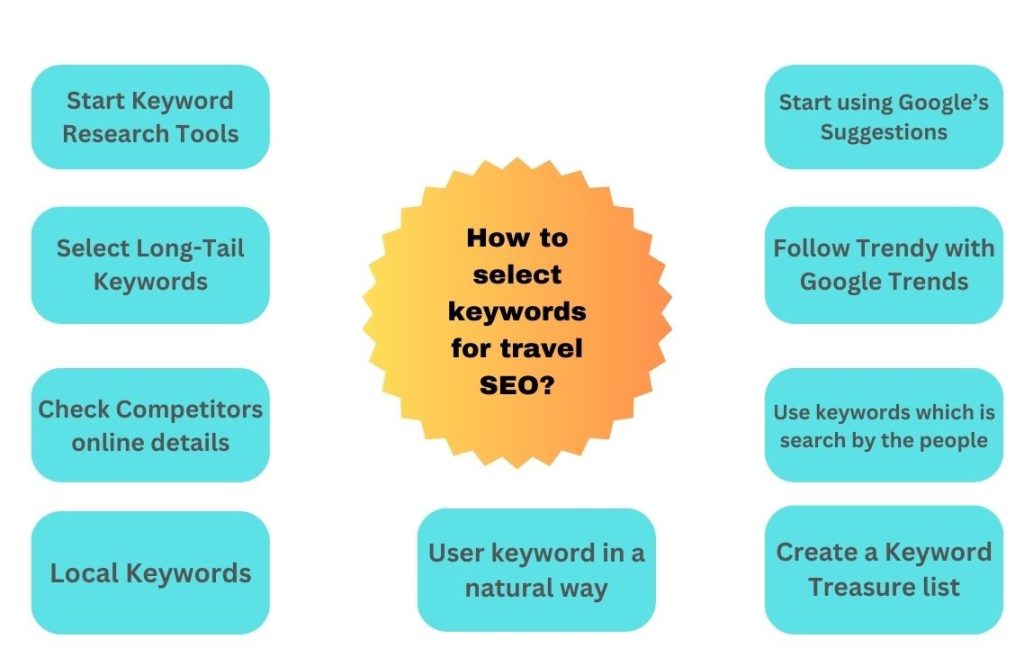
- Start Keyword Research Tools: Equip yourself with powerful keyword research tools like Google Keyword Planner, SEMrush, or Ahrefs. These tools are your trusty companions, providing valuable insights into search volume, competition, and keyword variations for travel seo.
- Select Long-Tail Keywords: Long-tail keywords are the hidden treasures of SEO that cover travel SEO websites. They’re specific phrases that travelers use when seeking information. Long-tail keywords often have less competition, making it easier to rank for them. Think “family-friendly resorts in Florida” or “budget road trips in California.”
- Check Competitors online details : Take a peek at what your competitors are up to. Analyze their websites to identify the top keywords they are ranking for, especially those related to travel in the USA. Tools like SEMrush or SpyFu can be your secret agents in this mission for your travel seo.
- Local Keywords: If your travel business caters to specific USA locations, select local keywords for the travel website. Examples include “New York City hotels” or “Los Angeles travel tips.”
- Start using Google’s Suggestions: As you start typing a search query in Google, it generously suggests popular searches and what questions people ask mostly. You also can get some idea from about the travel related keyword. For the SEO of your travel website. These suggestions can be pure gold in discovering relevant keywords.
- Follow Trendy with Google Trends: Use Google Trends to keep up with what’s hot topic in searches and what’s happening in the world of USA travel. This tool helps you align your content with the latest trends and popular searches. You also can define the area in which you want to check your search travel. It also will help you choose the right keyword for your travel website.
- Use keywords which is search by the people: Understand the intent behind the keywords. Are users looking for information, booking options, or travel tips? these keywords in your travel website and then optimize your content as per your audience search.
- Create a Keyword Treasure list: Organize your chosen keywords in a spreadsheet. Include essential metrics like search volume and keyword difficulty to prioritize them effectively for your travel website.
- User keyword in a natural way: Once you’ve unearthed those precious keywords, use them wisely. Naturally incorporate them into your travel website content, in titles, headings, and throughout your articles.
Remember, don’t overstuff your content with keywords; it should be naturally to read.
Tools and Strategies for Effective Keyword Research
- Google Keyword Planner: A free tool that help you to provides keyword ideas, search volume data, and competition levels for your travel website.
- SEMrush and Ahrefs: This is one of the paid tools that offer in-depth keyword research and competitor analysis features.
- Google Trends: It Helps you identify keyword trends and seasonal variations.
- Keyword Difficulty Checker: That tools used for Keyword Explorer to assess how hard it is to rank for a specific keyword.
- Content Optimization Tools: Platforms like Yoast SEO can assist in optimizing your content for selected keywords for your travel website.
Keyword research is your trusty compass in the vast wilderness of Travel SEO.
By understanding its importance, brainstorming relevant keywords, and employing the right tools and strategies, you’re on your way to executing and using the travel SEO keywords for your website.
Keep in mind that SEO is an ongoing expedition, so regularly monitor your keywords’ performance and adapt your strategy as needed. With the right keywords as your guide, your travel website is destined for success, helping you connect with eager travelers looking for their next adventure.
2.On-Page SEO for Travel Websites
In these essential aspects of On-Page SEO for Travel Websites. You’ll learn about critical things you can do on-page for travel website. In this elements like meta titles, meta descriptions, headers, and content optimization.
By the end of this adventure, you’ll be equipped with the knowledge of SEO and tools to enhance your travel-related content and climb the SEO for travel websites.
Understanding On-Page SEO for Travel Websites
Before we dive into the deep concept of On-Page SEO for your travel seo, let’s get a clear picture of what is in it:
On-page SEO refers to the optimization of individual web pages of the website. To improve their search engine rankings and attract organic traffic. You have to do on-page SEO for your travel website. It involves optimizing various on-page elements to make your content more accessible and appealing to both search engines and human readers as well.
Now, let’s unpack the key On-Page SEO elements that will set your travel website on the path to success.
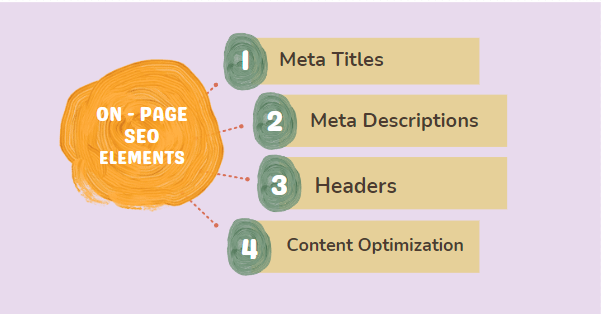
- Meta Titles: Meta titles are like the headlines of your web pages. They are displayed as the clickable link in search engine results and are crucial for grabbing the attention of potential visitors on your travel website. Here’s how to optimize them:
(Key to write your meta title for your travel website. Be Descriptive: Craft a concise, descriptive title that accurately reflects the content of your page.)
- Include Keywords: Incorporate relevant keywords naturally( which feels natural while reading the content on your travel website), preferably near the beginning of the title.
- Keep it Under 60 Characters: Ensure your meta title is under 60 characters to prevent truncation in search results and also grab the attention of readers. it should be catchy as well. The bonus is to contain numbers if you can.
2. Meta Descriptions
Meta descriptions provide a brief summary of your page’s content of your website. It also displayed beneath the meta title in search results of your website. To optimize them:
- Be Informative: Write a compelling and informative meta description for your website. Which also encourages users to click through to your travel website.
- Incorporate Keywords: Include relevant keywords to signal to search engines that your content is relevant to the your targeted audience of your website and related to its quired questions.
- Stay Under 160 Characters: Keep your meta description concise, typically under 160 characters, to ensure it’s fully visible in search results. It was also easy and simple to read.
- Headers (H1, H2, H3, etc.)
Headers are used to structure of web page content and make it more readable. Search engines pay attention to header tags, so here’s how you can optimize them:
- H1 Tag: Use the H1 tag for your main page title or headline. This is the most important header on the page of website and the important part of travel seo websites.
- H2 and H3 Tags: Use H2 and H3 tags for subheadings and subsections. These help organize your content and make it more scannable.
- Include Keywords: Incorporate relevant keywords in your headers, especially in the H1 tag.
- Content Optimization
Now, let’s dive into travel seo part , the heart of your website – the content itself:
- Quality is Key: Create high-quality, informative, and engaging content that satisfies the user’s intent. The longer people stay on your page, the better it is for travel SEO website.
- Keyword Usage: Naturally include your target keywords throughout the content, but don’t overstuff. Aim for a keyword density of around 1-2%.
- Internal Linking: Link to other relevant pages on your website where appropriate. This helps users navigate your site and improves travel SEO of your website.
- Images and Alt Text: Use high-quality images and include descriptive alt text. This not only enhances user experience but also benefits image travel SEO of your website .
Tips for Optimizing Travel-Related Content
Now that you understand the on-page elements, here are some additional tips specifically tailored for travel websites:
- Local SEO: If your travel business operates in specific locations within the USA, optimize your content for local keywords and mention local attractions, hotels, and landmarks.
- User-Generated Content: Encourage user reviews and testimonials for hotels, restaurants, and attractions. These add credibility and fresh content to your pages.
- Schema Markup: Implement schema markup for travel-related information like reviews, ratings, and pricing. This can enhance your visibility in search results.
- Mobile Optimization: Ensure your website is mobile-responsive, as many travelers use smartphones and tablets to plan their trips.
Congratulations! You’ve now embarked on the path to mastering On-Page SEO for your travel website.
By optimizing your website on the basis of meta titles, meta descriptions, headers, and your content, you’re setting the stage for better search engine rankings and improved user experience.
Remember, SEO is an ongoing journey, so continue to monitor your performance and adapt your strategies as needed. With dedication and these SEO techniques, your travel website is well on its way to becoming a top destination for travelers in search of adventure.
3.Local SEO for Travel Businesses
Now you have to dive into the world of Local SEO. In this beginner-friendly guide, we’ll explore the ins and outs of Local SEO for your travel website.
In this you will know how it can work wonders for your business. We’ll particularly emphasize the significance of local SEO for hotels, restaurants, and local attractions.
Plus, we’ll provide you with a step-by-step roadmap for optimizing your Google My Business listing and local citations. As we do for our website.
Let’s start… First understand.
Why Local SEO Matters for Travel Businesses?
Local SEO is the secret sauce that can make your travel business shine in your local community and attract travelers from around the world.
Here’s why Because it will:
- Enhanced Visibility: Local SEO helps your business appear in local search results when travelers are looking for services in your area. This increased visibility can lead to more bookings, reservations, and visits.
- Trust and Credibility: Businesses that rank well in local searches are often perceived as more trustworthy and credible. Travelers are more likely to choose businesses that appear at the top of the list.
- Mobile Optimization: Many travelers use smartphones to search for nearby hotels, restaurants, and attractions. Local SEO ensures your business is easily found by mobile users.
Now, let’s embark on our journey through the steps of optimizing Local SEO for your travel business.

Step 1: Claim and Optimize Your Google My Business Listing
Your Google My Business (GMB) listing is your digital storefront, and it’s crucial to make it shine.
- Claim Your GMB Listing: If you haven’t already, claim your GMB listing. Go to the Google My Business website, follow the prompts, and verify your ownership.
- Complete Your Profile: Fill out every section of your GMB profile, including your business name, address, phone number, website, and business hours. Add high-quality photos and videos to showcase your business.
- Choose the Right Categories: Select the most relevant categories for your business. Be specific; for example, if you run a boutique hotel, don’t just choose “hotel,” but also “boutique hotel.” Here you choose travel.
- Write a Compelling Description: Craft an engaging business description that highlights what makes your travel business unique. Include relevant keywords and phrases naturally.
- Collect and Respond to Reviews: Encourage satisfied customers to leave reviews on your GMB listing. Respond to reviews promptly, both positive and negative, to show you value customer feedback.
Step 2: Build Local Citations
Local citations are mentions of your business name, address, and phone number (NAP) on other websites and directories. They are essential for local SEO and for your travel business.
- Consistency is Key: Ensure that your NAP information is consistent across all online directories, including your website, GMB listing, and other platforms like Yelp and TripAdvisor as well.
- Claim Listings: Claim and verify your business listings on popular directories like Yelp, TripAdvisor, and Yellow Pages. Fill out your profiles completely.
- Build New Citations: Seek out local business directories and travel-related websites where you can create listings for your business.
Ensure your NAP information is accurate.
Step 3: Optimize Your Website
Your travel website is the digital hub of your travel business. Here’s how to optimize it for local SEO:
- Location Pages: Create dedicated location pages for different aspects of your business, such as individual hotel rooms, restaurant menus, or attraction descriptions. Optimize these pages with relevant keywords and NAP information.
- On-Page SEO: Optimize your website’s on-page elements, including meta titles, meta descriptions, headers, and content, with local keywords.
- Mobile Optimization: Ensure your website is mobile-responsive for travelers searching on smartphones.
Step 4: Local Content Creation
Create valuable local content that showcases the uniqueness of your travel business and your website as well.
- Blogs: Write blog posts about local events, attractions, and insider travel tips.
- Local Guides: Create guides to your city or region, highlighting the best things to see and do.
- Customer Stories: Share customer testimonials and stories about their experiences at your establishment.
Step 5: Monitor and Adapt
Regularly monitor your local SEO efforts using tools like Google Analytics and Google Search Console. Pay attention to your rankings, reviews, and website traffic.
Adapt your strategy based on the data to continuously improve your local SEO of your travel business.
By optimizing your Google My Business listing, building local citations, enhancing your website, creating local content, and monitoring your progress.
4.Content Creation for Travel SEO
In this beginner’s guide to content creation for travel SEO, we’ll walk you through the essential steps to create captivating and SEO-friendly content for your website that can boost your travel business. From understanding the importance of valuable content to generating ideas for travel-focused articles, Here we’ve got you covered. Just like we have for our project.
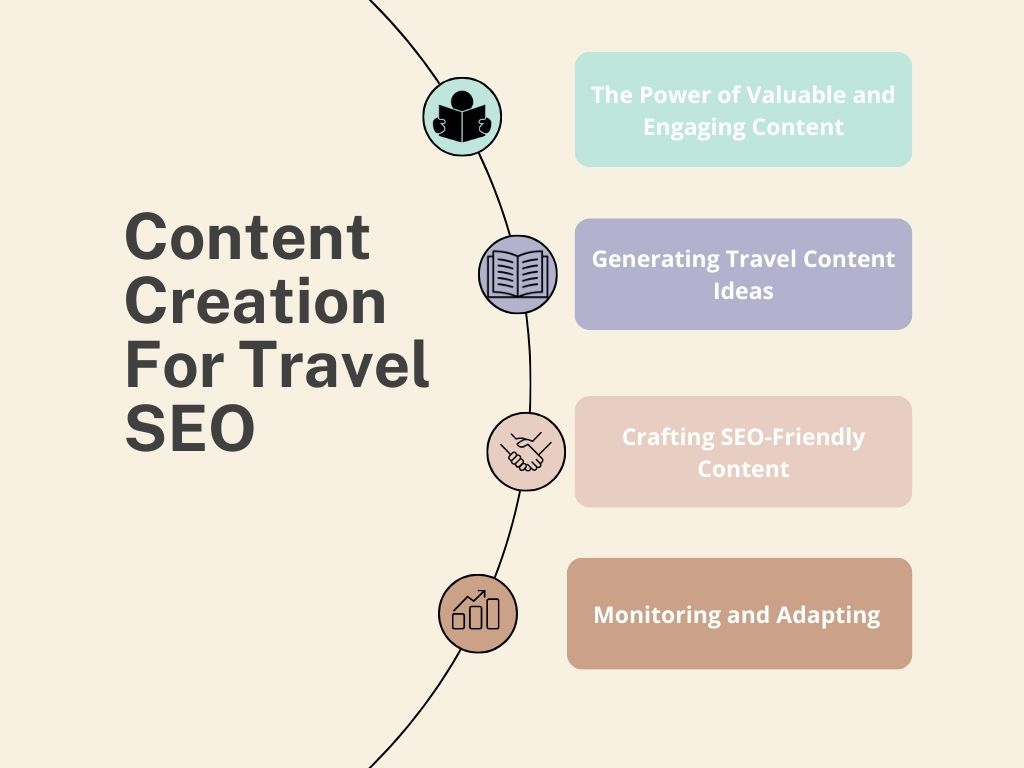
The Power of Valuable and Engaging Content
Before we delve into the technicalities of SEO, let’s first understand why creating valuable and engaging content is crucial for your travel business.
- Building Trust and Authority : In the travel industry, trust is paramount. High-quality content that provides valuable information, such as travel guides, tips, and personal experiences, helps establish your business as a credible source. When users trust your content, they are more likely to trust your recommendations, assistance and services.
- Enhancing User Experience: Engaging content keeps visitors on your website longer, reducing bounce rates. This improved user experience signals to search engines that your site is valuable, leading to higher search rankings.
- Encouraging Sharing and Backlinks: Compelling content gets shared on social media and linked to by other websites. These social signals and backlinks can significantly impact your SEO efforts.
Generating Travel Content Ideas
Now that you understand the importance of valuable content for Travel SEO. let’s explore some travel content ideas.
- Destination Guides : Create in-depth guides for popular travel destinations, covering attractions, accommodations, local cuisine, and cultural insights.
- Travel Tips and Hacks: Offer practical tips and travel hacks to help your audience plan their trips more efficiently and cost-effectively.
- Itinerary Suggestions : Provide sample itineraries for different types of travelers, such as “The Ultimate Adventure Weekend” or “A Relaxing Spa Retreat.”
- Personal Travel Stories: Share your own travel experiences, including memorable moments, challenges faced, and lessons learned.
Crafting SEO-Friendly Content
Now that you have content ideas, let’s learn how to create content that’s optimized for search engines.
- Quality Over Quantity: Focus on producing high-quality content that genuinely helps your audience rather than churning out numerous articles.
- User-Friendly Formatting : Use headings, bullet points, and images to break up the text and make it easier to read.
- Internal and External Links: Incorporate internal links to other relevant pages on your website and external links to authoritative sources.
- Regular Updates: Keep your content up-to-date, especially when it comes to travel information, as things can change rapidly.
Monitoring and Adapting
SEO is an ongoing process. Continuously monitor the performance of your content using tools like Google Analytics. Analyze which articles are driving traffic, engagement, and conversions, and adapt your strategy accordingly.
Creating SEO-friendly content for your travel business is a journey that requires dedication and ongoing effort. By providing valuable and engaging content, optimizing it for search engines, and staying attuned to the needs of your audience, you can boost your SEO rankings and grow your travel business.
5.Backlink Building Strategies
The fascinating world of Backlink Building for Travel Businesses!
If you own or manage a travel-related website, you’re in for an exciting journey of SEO to do travel seo for your website.
In this we’ll unravel the importance of quality backlinks and unveil effective techniques to acquire authoritative backlinks for your travel website.
How we do for one of our projects because your online presence is about to take flight!
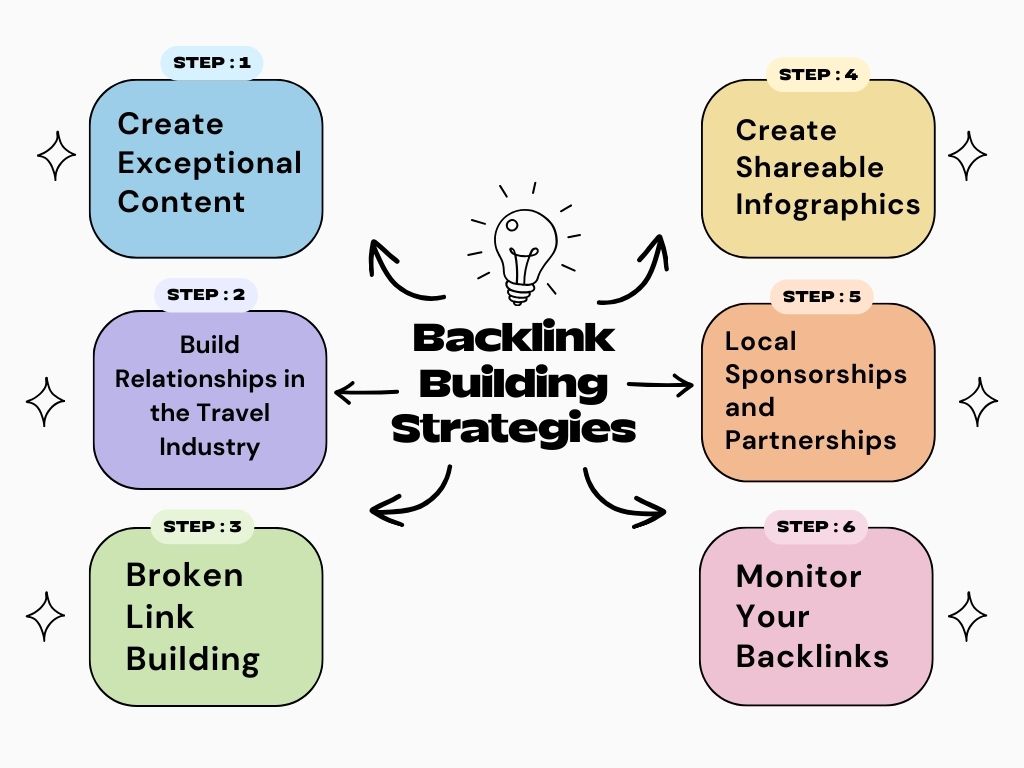
Understanding the importance of Quality Backlinks in Travel SEO
Before we dive into the how, let’s understand the why. Quality backlinks, or inbound links from other websites to yours, are importants. Here’s why they’re essential for your travel business:
- Boost in Authority: It helps Search engines like Google view websites with more quality backlinks as authoritative and trustworthy. This can lead to higher rankings in search results. It is one of most important aspects of travel seo for your website.
- Increased Traffic: Quality backlinks from reputable sources can redirect targeted traffic to your travel website. These visitors are more likely to engage with your content and services.
- Building Connections: Building backlinks often involves networking with other travel-related websites and businesses. which can lead you to valuable partnerships and collaborations.
Now, let’s embark on a journey through effective techniques for acquiring authoritative backlinks for your travel website.
Step 1: Create Exceptional Content
Quality content is the currency of the internet. When you produce outstanding content, other websites are more likely to link to it. Here’s how to do it:
- Informative Blog Posts: Write in-depth, informative blog posts about travel destinations, tips, and experiences. It should be different from your travel website.
- Visual Content: Use high-quality images and videos in your content to make it more engaging and shareable.
- Original Research: Conduct surveys or research related to travel trends and share your findings.
- Guides and Resources: Create valuable travel guides, checklists, and resources that travelers find helpful.
Step 2: Build Relationships in the Travel Industry
Networking is crucial in the travel industry, both offline and online. Here’s how to build relationships that can lead to backlinks:
- Collaborate with Influencers: Partner with travel influencers to create content or promotions that include links to your website.
- Guest Posting: Write guest posts for reputable travel blogs and websites, including a link back to your site in your author bio.
- Connect on Social Media: Engage with other travel businesses and bloggers on social media platforms. Share and comment on their content to foster relationships.
Step 3: Broken Link Building
This technique involves finding broken links on other travel websites and offering your content as a replacement. Here’s how to do it:
- Identify Relevant Websites: Search for travel websites or blogs in your niche that may have broken links.
- Use Tools: Utilize online tools like Check My Links or Broken Link Checker to identify broken links on these websites.
- Offer Replacements: Reach out to the website owner or webmaster and suggest your relevant content as a replacement for the broken link.
Step 4: Create Shareable Infographics
Infographics are highly shareable and link-worthy. Create visually appealing infographics related to travel and share them on your website and social media platforms. Encourage others to use them on their websites with proper attribution.
Step 5: Local Sponsorships and Partnerships
If your travel business operates in a specific location, consider sponsoring local events, organizations, or charities. Many times, these sponsorships can lead to backlinks from event websites or partner organizations.
Step 6: Monitor Your Backlinks
Use tools like Ahrefs or Moz to monitor your backlinks.
If you notice any low-quality or toxic backlinks, disavow them through.
Google Search Console to maintain a healthy backlink profile.
You set up a treasure trove of knowledge on backlink building for travel businesses. By creating exceptional content, building relationships, fixing broken links, crafting infographics, exploring local sponsorships, and monitoring your backlinks, you’re well-equipped to boost your travel website’s authority and visibility.
Remember, building quality backlinks is an ongoing journey, so stay persistent and continue to build meaningful connections within the travel industry.
Your travel seo website is now on the path to soaring to new heights in the competitive world of online travel.
6.Website Speed ,Mobile Optimization and (UX)
We already walk you through the crucial steps of website speed improvement, mobile optimization, and creating a top-notch user experience (UX) that not only delights your visitors but also boosts your SEO.
The Mobile Revolution
Why Mobile Matters?
Travelers are increasingly using smartphones to plan their journeys. Having a mobile-friendly website is essential as it caters to the needs of on-the-go travellers. It improves accessibility and ensures that your content reaches a wider size of audience.
Tips for Mobile Optimization
- Responsive Design: Ensure your website adapts seamlessly to different screen sizes.
- Fast Loading: Optimize images and minimize scripts for swift page loading.
- Mobile-First Approach: Design your website with mobile users in mind from the start.
Speed is of the Essence
A slow website can drive away potential customers faster than you can say “jet set.” Speed is a critical factor in user satisfaction and SEO rankings.
Tips for Speedy Travel Websites
- Optimize Images: Compress images without compromising quality.
- Minimize HTTP Requests: Reduce the number of requests for resources.
- Use a Content Delivery Network (CDN): Deliver content from servers closest to your users.
The User Experience (UX) Advantage
What is UX?
UX encompasses everything a user experiences on your site – from design and navigation to content and performance. A great UX keeps visitors coming back.
How UX Boosts SEO?
- Lower Bounce Rates: A good UX keeps visitors engaged and reduces bounce rates.
- Higher Dwell Time: When users enjoy their experience, they spend more time on your site, sending positive signals to search engines.
- Increased Conversions: A user-friendly site encourages bookings and inquiries.
UX Best Practices for Travel Websites
Fast Loading Times
- Prioritize Critical Content: Ensure the most important content loads first.
- Compress Resources: Compress CSS, JavaScript, and HTML files to reduce loading times.
Easy Navigation
- Clear Menu Structure: Organize your content logically in the navigation menu.
- Search Functionality: Implement a robust search feature to help users find what they need quickly.
Engaging Content
- Visually Appealing: Use high-quality images and videos to showcase destinations.
- Personalization: Offer personalized travel recommendations based on user preferences.
Booking and Contact
- Simplify Booking: Make the booking process as straightforward as possible.
- Contact Information: Ensure contact details are easily accessible for inquiries and assistance.
Continuous Improvement
Your journey to an optimized travel website doesn’t end here. Continuously monitor your site’s performance, gather user feedback, and adapt to changing trends and technologies.
By focusing on mobile optimization, improving website speed, and providing an exceptional user experience, you’re not only making your travel business more accessible and enjoyable for travelers but also boosting your SEO rankings of your travel website.
Remember, a happy user is a returning user, and an SEO-optimized website is a magnet for traveler seeking their next adventure. Safe travels on your journey to website optimization!
7. Technical SEO for Travel
The technical aspects of SEO step by step, addressing crucial elements like site speed, HTTPS, schema markup, and offering solutions to common technical SEO issues.
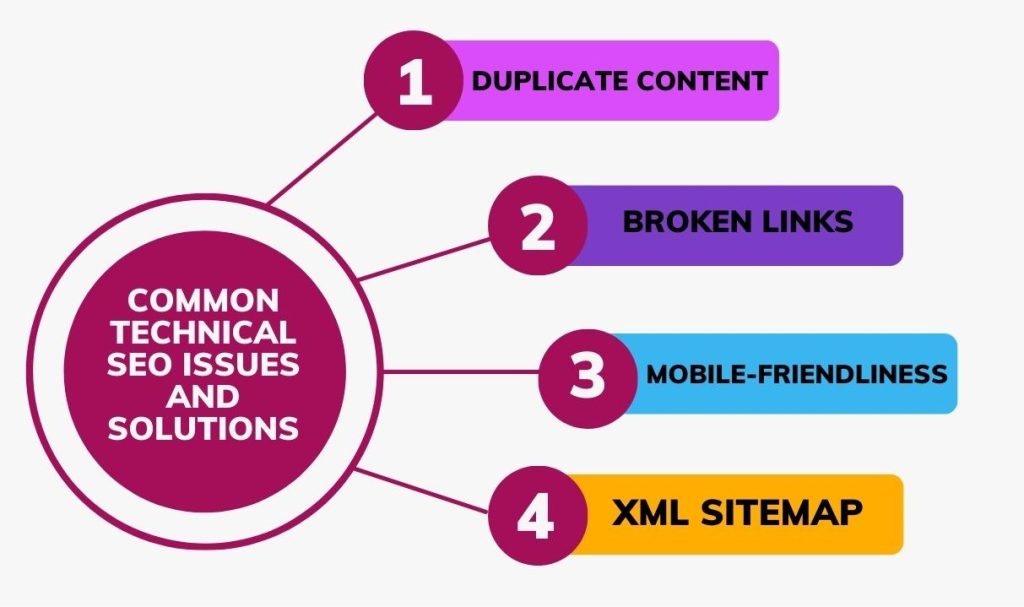
The Foundation – Site Speed
Site speed is critical for user experience and SEO. Slow-loading websites can discourage travelers and hurt your rankings.
Tips to Boost Site Speed
- Image Optimization: Compress images and use responsive formats.
- Minimize HTTP Requests: Reduce the number of elements on your web pages.
- Leverage Browser Caching: Allow browsers to store frequently used resources.
- Content Delivery Network (CDN): Use a CDN to distribute content geographically.
Secure Your Site with HTTPS
The Importance of HTTPS
A secure site is essential for both user trust and SEO. Google considers HTTPS a ranking factor.
Steps to Implement HTTPS
- Obtain an SSL Certificate: Contact your hosting provider or use a service like Let’s Encrypt.
- Update Internal Links: Ensure all internal links use the HTTPS protocol.
- Update Sitemaps and Robots.txt: Ensure your sitemap and robots.txt files reflect the HTTPS URLs.
Schema Markup for Enhanced Visibility
What is Schema Markup?
Schema markup is a type of structured data that helps search engines understand the content on your site better.
How to Implement Schema Markup?
Identify Relevant Schemas: Use Google’s Structured Data Markup Helper to find suitable schemas for your content.
Add Markup to Your HTML: Include schema markup in your HTML code to describe elements like events, reviews, and destinations.
Common Technical SEO Issues and Solutions
Duplicate Content
Issue: Duplicate content can confuse search engines and dilute your rankings.
Solution: Use canonical tags to indicate the preferred version of a page.
Broken Links
Issue: Broken links frustrate users and negatively impact SEO.
Solution: Regularly check for broken links using tools like Screaming Frog and fix them promptly.
Mobile-Friendliness
Issue: A lack of mobile optimization can hurt rankings, considering the rise of mobile users.
Solution: Ensure your website is responsive and provides a seamless experience on mobile devices.
XML Sitemap
Issue: An outdated or incomplete XML sitemap can hinder search engines from indexing your site properly.
Solution: Regularly update your XML sitemap and submit it to Google Search Console.
Continuous Improvement
Remember, Technical SEO is an ongoing process. Regularly monitor your website’s performance, use tools like Google Search Console to identify issues, and stay updated with the latest SEO trends and algorithms.
By mastering Technical SEO for your travel website, you’re not only ensuring better visibility on search engines but also providing a smoother experience for your travelers.
As your address site speed, secure your site with HTTPS, implement schema markup, and resolve common technical SEO issues, you’ll be well on your way to attracting more visitors and helping them embark on their dream journeys.
8.SEO Analytics and Monitoring
Now , Understand how your SEO efforts are performing and how to improve them. we’ll walk you through the importance of tracking SEO performance and introduce you to essential tools and metrics for monitoring your travel website’s SEO efforts.
The Significance of Tracking SEO Performance
Why Tracking Matters ?
Tracking SEO performance is like having a compass for your online success. It allows you to:
- Measure Progress: See how your efforts impact your website’s visibility and traffic.
- Identify Issues: Detect and address problems that may hinder your site’s ranking.
- Make Informed Decisions: Use data to guide your SEO strategy and investments.
Tools for Monitoring Travel SEO
Google Analytics
Google Analytics is a powerful, free tool that provides in-depth insights into your website’s traffic, user behavior, and more. Set it up by:
- Creating an Account: Sign up for Google Analytics with your Gmail account.
- Adding Tracking Code: Insert a small piece of tracking code into your website’s HTML.
Google Search Console
Google Search Console helps you understand how Google views your website. To get started:
- Add Your Website: Verify your site ownership and access important data.
- Submit a Sitemap: Ensure Google indexes all your relevant pages.
SEO Monitoring Tools
Consider using specialized SEO monitoring tools like Moz, SEMrush, or Ahrefs to track keyword rankings, analyze competitors, and receive actionable suggestions.
Essential SEO Metrics
- Organic Traffic : Monitor the number of visitors coming to your website from search engines. Analyze changes over time to understand the impact of your SEO efforts.
- Keyword Rankings: Track the position of your target keywords on search engine results pages (SERPs). Are they moving up or down? Adjust your strategy accordingly.
- Click-Through Rate (CTR) :Measure how often users click on your search results. A high CTR indicates that your titles and descriptions are enticing.
- Bounce Rate : Keep an eye on the bounce rate, which shows the percentage of visitors who leave your site after viewing only one page. A lower bounce rate typically indicates better user engagement.
- Conversion Rate : Monitor the percentage of visitors who complete a desired action, such as booking a trip or signing up for a newsletter. This metric reflects the effectiveness of your site in achieving its goals.
Analyzing and Acting on Data
- Regular Analysis : Set aside time to review your SEO data regularly. Look for trends, spikes, or drops in traffic and rankings.
- Content Improvement : Use your data to identify top-performing content and areas that need improvement. Update and optimize accordingly.
- Backlink Profile : Monitor your backlinks for quality and relevance. Disavow toxic links and build relationships for high-quality backlinks.
- Mobile Optimization : Analyze your mobile traffic and ensure your site is well-optimized for mobile devices.
- Continuous Learning and Adaptation : SEO is dynamic, and search engine algorithms evolve. Stay updated with industry trends, Google algorithm changes, and emerging SEO techniques to adapt your strategy accordingly.
By tracking SEO performance using tools like Google Analytics and Google Search Console and monitoring essential metrics such as organic traffic, keyword rankings, CTR, bounce rate, and conversion rate, you’ll gain valuable insights into your travel website’s performance. This data-driven approach will empower you to make informed decisions, enhance your SEO strategy, and ultimately attract more travelers to explore the world through your website.
Challenges in Travel SEO
In the travel seo we have facing many different and common challenges and obstacles. Which is faced by travel businesses in the SEO landscape and Now are sharing solutions and strategies to overcome them. Because we also face and overcome them.
The Complex Landscape of Travel SEO
Why Travel SEO is Different?
The travel industry is highly competitive, and SEO can be a battlefield. Challenges include:
- Intense Competition: Numerous businesses vying for the same keywords and audience.
- Seasonality: Demand for travel varies by season, requiring adaptive strategies.
- Changing Algorithms: Search engines continuously update their algorithms, affecting rankings.
Common Challenges in Travel SEO
Seasonal Fluctuations
Challenge: Travel demand varies by season, leading to unpredictable traffic.
Solution: Plan and create content around seasonal trends well in advance, optimizing for timely queries.
High Competition for Keywords
Challenge: Top travel keywords are fiercely competitive, making it difficult to rank.
Solution: Focus on long-tail keywords, targeting specific niches within the travel industry.
Mobile Optimization
Challenge: Many travelers use mobile devices, and non-mobile-friendly sites can deter users.
Solution: Ensure your website is responsive and optimized for mobile users.
Content Freshness
Challenge: Travel information changes frequently, requiring constant content updates.
Solution: Regularly update and improvise destination guides, travel tips, and itineraries as per climate and latest information to stay current.
Strategies to Overcome Travel SEO Challenges
- Long-Tail Keywords: Research and target long-tail keywords specific to your travel niche. These may have less competition and more focused user intent.
- Seasonal Content Planning : Develop a content calendar that aligns with seasonal travel trends. Plan and create content well in advance, so it’s ready to publish when needed.
- Mobile Optimization : Prioritize mobile optimization in your website design and ensure a seamless experience for mobile users.
- Regular Content Updates : Create a schedule for content audits and updates. Use tools like Google Analytics to identify outdated pages.
User Experience (UX) Matters
The Role of UX in Travel SEO
A positive user experience is crucial for retaining visitors and improving SEO. Travel websites should focus on:
- Fast Loading Times: Ensure your website loads quickly on all devices.
- Intuitive Navigation: Make it easy for users to find information.
- Engaging Content: Create content that provides value and keeps users on your site.
Continuous Learning and Adaptation
SEO is an ever-evolving field. Stay updated with industry trends, algorithm changes, and emerging SEO techniques. Regularly monitor your SEO efforts and adapt your strategy as needed.
While travel SEO presents its unique set of challenges, with the right strategies and a dedication to providing a great user experience, you can overcome these obstacles and thrive in the competitive travel industry. By targeting long-tail keywords, planning for seasonality, optimizing for mobile, and keeping your content fresh, you’ll be well on your way to attracting travelers and helping them explore the world through your website.
Upcoming latest future Trends in Travel SEO :2023
Why Staying Updated Matters?
The travel industry is constantly changing, and so is SEO. Staying informed about emerging trends and technologies is essential to remain competitive. It also help you make stand in the online market.
Emerging Trends in Travel SEO
Voice Search Optimization
- Trend: With the rise of virtual assistants and smart speakers, voice search is becoming more prevalent.
- Action: Optimize your content for natural language queries and long-tail keywords.
Visual Search
- Trend: With the rise of virtual assistants and smart speakers, voice search is becoming more prevalent.
- Action: Optimize your content for natural language queries and long-tail keywords.
Visual Search
- Trend: Users can now search for travel destinations and experiences using images.
- Action: Optimize your images with descriptive alt text and consider adding image recognition technology to your site.
User-Generated Content
- Trend: Travelers trust fellow travelers. User-generated content, like reviews and photos, is gaining prominence.
- Action: Encourage customers to leave reviews and share their experiences on your website.
Video Content
- Trend: Video marketing is booming in the travel industry. Travelers love visual content.
- Action: Create engaging travel videos, including destination highlights, travel tips, and virtual tours.
Technologies Shaping the Future
Artificial Intelligence (AI)
- Trend: AI can personalize user experiences, recommend travel options, and enhance chatbots for customer support.
- Action: Consider implementing AI-driven features on your website to improve user engagement.
Augmented Reality (AR)
- Trend: AR can provide travelers with immersive experiences, such as virtual tours of accommodations or attractions.
- Action: Explore AR applications that enhance travel planning and experiences on your website.
Blockchain Technology
- Trend: Blockchain can increase transparency and security in travel bookings and transactions.
- Action: Investigate how blockchain can be integrated into your payment and booking systems.
Mobile-First Indexing
- Trend: Google prioritizes mobile-first indexing, meaning it primarily uses the mobile version of a website for ranking and indexing.
- Action: Ensure your website is mobile-responsive and offers a seamless experience on smartphones and tablets.
Continuous Learning and Adaptation
As new trends and technologies continue to emerge, it’s crucial to keep learning and adapting. Stay updated with industry news, attend conferences, and experiment with new strategies.
The future of travel SEO is filled with exciting possibilities. By embracing trends like voice search, visual content, and user-generated content, and exploring technologies like AI, AR, and blockchain, you can stay ahead in the competitive travel industry. Remember, continuous learning and adaptation are key to navigating the ever-evolving landscape of travel SEO. Embrace the future, and you’ll be well on your way to attracting travelers and
helping them embark on their dream journeys with good travel seo.
Conclusion
In the ever-evolving world of travel, where wanderlust meets the internet, SEO is the compass guiding businesses and enthusiasts to success. This guide gives you the map of creating new destinations through travel SEO, from keyword research and on-page optimization to local SEO, content creation, and link-building strategies. We’ve also navigated the importance of website speed, mobile optimization, and user experience while emphasizing the significance of analytics and monitoring.
We’ve shed light on the common challenges faced by travel SEO practitioners and provided practical solutions to overcome them. As we gaze into the future, we see exciting trends and technologies emerging, promising new horizons for the travel industry.
In closing, we also cover why it is essential to invest in SEO is not just a choice. It is also the path to greater visibility, credibility, and success. So, as you embark on your SEO journey, may it lead you to the farthest corners of the digital world and bring travelers from all around to explore the wonders you have to offer. So, Start optimizing your travel business with this treasurer information to make your website work like skyrocket.
